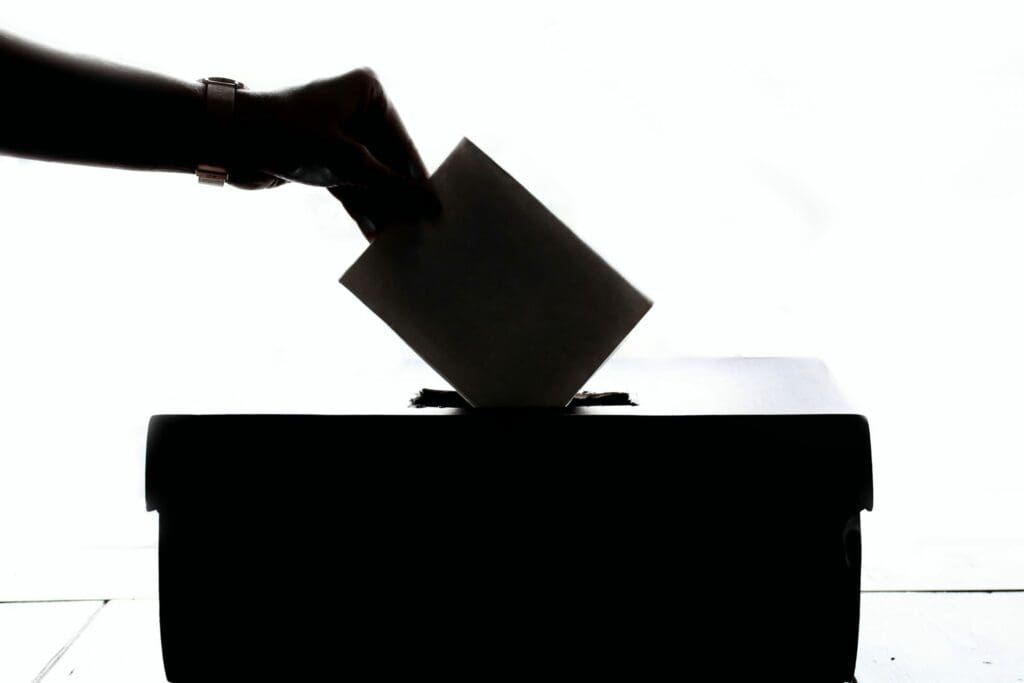By Dr James Fitzgerald, Dr R. Marie Santini, and Dr Débora Salles
This piece showcases the work of new VOX-Pol member, NetLab[1]. Its purpose is to provide readers with an initial understanding of a coordinated disinformation infrastructure that has flourished in Brazil, with a focus on how it interacted with the first round vote of the 2022 Brazilian General Elections. Future publications will discuss disinformation and violent extremism with reference to the second round vote and the aftermath of Luiz Inácio Lula da Silva’s victory.
Disinformation in Brazil
While the rise of fake news and disinformation is a global phenomenon, it is especially apparent in Brazil. There are a number of reasons for this. First, Brazil’s culture is distinctly audio-visual (as are the most viral forms of disinformation), owing to myriad factors including historically low literacy rates, the fusion of music with political identity and a pervasive 20th century cinema and television culture that helped to transcend class barriers in a hugely unequal country[2]. Second, social media use is very high across all age groups (‘Social media usage in Brazil – Statistics & Facts’), aided by structural allowances such as cheap mobile phone plans that offer unlimited use of social media apps, independent of access to the World Wide Web [a natural impediment to fact-checking]. WhatsApp is particularly embedded: over 96% of the Brazilian population are active users, 98% of messages are read by recipients (as opposed to 22% of emails) and approximately 58% of Brazilians use WhatsApp as their primary (and in many cases, exclusive) source of daily news —a tendency that naturally loosens structural ties to the consumption of media from established sources, such as the national paper of record (Folha do São Paulo) and the O Globo media network. Third—and the main focus of this piece—Brazil plays host to a sophisticated disinformation infrastructure that encompasses all major social media platforms (with WhatsApp at its fulcrum), capable of flooding the public sphere with coordinated messaging campaigns that can be calibrated to audience preferences and activated at very precise times. Finally, social media companies’ content moderation policies are lax in Brazil, allowing disinformation to spread at great(er) speed and to evade takedown measures that are more standard in the ‘Global North’.
Researchers at NetLab have been monitoring Brazil’s disinformation infrastructure since 2014, tracking its evolution across various political events. The first major deployment came in 2016, when Jair Bolsonaro’s team used the Rio de Janeiro municipal elections as a testing ground to funnel support to the senator’s son, Flávio. The campaign directed automated accounts (/social bots) to stoke political division on Twitter and blitzed public and private groups on Facebook and WhatsApp with pro-Bolsonaro sentiment. By fusing an emergent techno-populism with microtargeting strategies, the 2016 campaign consolidated an effective blueprint for “reducing the complexity of the demands of disaffected voters…and offering targeted solutions”, helping Flávio Bolsonaro to defy expectations and take 14% of the first round vote. Jair Bolsonaro would later admit that his son’s campaign was indeed a test-run for his 2018 presidential campaign and with proof of concept established (little wonder Bolsonaro refused to take part in televised debates), the intervening years saw a flood of investment and the development of a much more sophisticated disinformation infrastructure.
Activating the Disinformation Machine: October 2022, First Round, Brazilian General Elections
Ahead of the October 2022 elections, we encounter a disinformation infrastructure at its peak; as Santini explains, “What we are seeing in 2022 is very different from what we saw in 2018, in terms of complexity and strategy…this has a [much greater] scale, including the capacity for segmented targeting of audiences”. NetLab’s research determines that the infrastructure is built on two fundamentals: the “firehose of falsehood”—that is, a coordinated capacity to ‘flood the zone’ with disinformation at specific and politically sensitive times—and the “permanent campaign”—a steadier flow of disinformation that is audience-tested for efficacy and which, over the course of months and years, primes the ground for the gradual reception of familiar narratives.
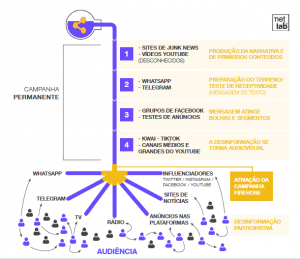
Per Figure 1, the permanent campaign operates across four, interlocking steps. First, massive volumes of “junk news” content are generated on dedicated websites and low user-base YouTube channels[3], thus creating a reservoir of shareable, hyperlinked media; Second, these media are distributed through WhatsApp groups and Telegram channels (public and private) in order to: a) test audience reception and virility of specific themes/messaging and; b) to prepare the ground for the future intensification of disinformation flows (that is to say, when the firehose is ‘activated’); Third, text and video content is targeted to key demographics and declared interest groups on Facebook, tightening a feedback loop for quality control across platforms and; finally, refined audio-visual content (shaped through insights gathered across steps 1-3) is pushed out through TikTok, Kwai and via high subscriber-base YouTube channels, creating a ‘cacophony effect’ whereby the same disinformation narratives are simultaneously encountered in public and private fora and across multiple platforms. As an addendum, this content is often amplified by national media outlets—such as the right-wing Jovem Pan network—which applies a further sheen of legitimacy (see Figure 2).
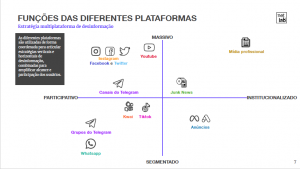
Once the firehose is activated, the (dis)information flows can be tweaked to precision. This is evidenced in Figure 3, a study in which NetLab analysed 550 Telegram groups (180,300 messages) and 193 WhatsApp groups (115,900 messages) to chart how the election fraud narrative—focused on voting machines being “hacked”—was intensified exactly two days before the first round of the election. This timing is important: it is a long-established trend in Brazilian elections that a large cohort of citizens tend to remain undecided in the 48-24 hours before voting—a figure that reached 14% in the 24 hours before first round voting began in 2022, according to reputable polling institute Datafloha.. Per Figure 3, the voter fraud narrative progresses similarly on both apps, hitting a peak when Lula overtakes Bolsonaro in the vote count. The content pertaining to this peak (13,899 messages in the Telegram sample, 7,845 messages in the Whatsapp sample) tries to establish that: a) the forewarned fraud campaign is underway; and b) a similar outcome will transpire in the second round vote, unless Bolsonaro’s supporters mobilise (Santini et al 2022, forthcoming).
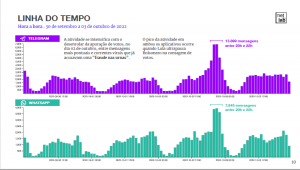
A Timeline of Falsehood: The Os Pingos Video, 01-02 October 2022
Figures 4 and 5 provide further insight into the malleability of the disinformation infrastructure, tracing how—on the eve and day of first round vote—a previously seeded narrative tying Lula to the criminal organisation Primeiro Comando da Capital (PCC) was pushed through the various platforms[4]. This single case demonstrates not only the coordinative power of the disinformation ‘machine’ (being one among thousands of disinformation media that flooded the system), but the complicity of social media companies in failing to adequately stem the flow. The developments are worth following in sequence:
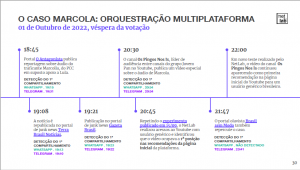
-At 18:45, a junk news outlet publishes audio of a PCC drug dealer (known as Marcolla) voicing his support for Lula. This audio is then published on junk news outlet Terroa Brasil Notícias at 19:08, before appearing on key Whatsapp groups and Telegram channels 2-5 minutes later.
-At 20:30, the YouTube channel Os Pingos Nos Is—a heavily subscribed right-wing YouTube channel tied to Jovem Pan—publishes a video discussing the audio message.
-Replicating a previous experiment, NetLab confirms that the Os Pingos video is the most heavily recommended YouTube video in Brazil within 15 minutes of publication and at 21:47, the Brasil Sem Medo network carries the video, including on Twitter.
-At 22:00, NetLab confirms that the video still appears as the ‘most recommended’ media on YouTube in Brazil.
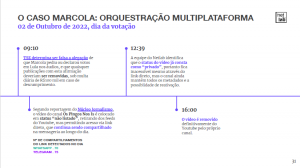
-At 09:00 on 2 October—the morning of the first round vote—the Superior Electoral Court (TSE) rules that all videos repeating the narrative tying Marcolla to Lula are to be taken down immediately, with a fine of R$100,000 per day (c. €20,000) in case of non-compliance.
-At 9.30, a report from Núcleo Jornalismo confirms that although the Os Pingos video has been ‘unlisted’ on YouTube—and therefore not showing via searches, recommendations or feeds—the video is still accessible via hyperlink: NetLab subsequently detects at least 70 separate shares of the hyperlink across the observed Whatsapp groups, and 75 across the Telegram groups.
-At 12:39, NetLab confirms that the Os Pingos video is now “private”, hence it is inaccessible via hyperlink, but the YouTube channel retains all the metadata and the video remains available for reactivation.
-At 16:00, the video is fully removed from YouTube, deleted by the Os Pingos channel itself.
-Voting closes at 17.00.
Conclusion
On the evening of 30 October 2022, Lula was declared incumbent President of Brazil. A victory owing so much to his force of personality and a nostalgic appeal for a better Brazil, his campaign was notably light on policy and owed very little to an orchestrated social media strategy that had been so essential to his opponent. In the end, left and right-wing futures for Brazil were separated by the thinnest margin in its electoral history (1.8%), highlighting not only a divided country, but the clear capacity for disinformation to tip the democratic balance.
The periods before, during and after the elections have been marked by acts of violent extremism—the vast majority emanating from Bolsonaro supporters. In the agricultural heartlands of Mato Grosso, a heated exchange about politics ended with Bolsonaro supporter Rafael Silva de Oliveira murdering his Lula supporting colleague with an axe. In the Northeastern state of Ceará, a man entered a bar calling for political affiliations before shooting dead a PT supporter. Much further to the South, in Belo Horizonte, an intoxicated man took to the streets upon hearing the election results and proceeded to open fire on a crowd of celebrating Lula supporters, killing two, including a 12-year old child. According to Agencia Publica, there were three politically-motivated acts of violence per day in Brazil in the period 16 August to 2 October and another study found that 55% of running deputies and senators were directly affected by political violence during their election campaigns[5]. In the weeks since Bolsonaro’s defeat, a substantial number of protestors have mobilised across Brazil, variously calling for military intervention to “save the country” and reciting themes commonly spread via the disinformation networks that have helped to glue this social movement as a prominent (and righteous) political force.
While such events signify the violent extremes of layered social phenomena, NetLab’s work offers an essential conclusion: the flow of falsehood(s) in Brazil cannot be exclusively tied to the organic outgrowth of political frustration and division (though these issues clearly take primacy); rather, these narratives are also products of a highly sophisticated and well-funded “campaign of disinformation” built to support the institutionalisation of far-right politics and to spread pro-Bolsonaro sentiment through society. Ahead of four crucial years, much work is required to confront and dismantle what journalist Patricia Campos Mello has called “the Machine of Hate” and to this end, social media companies must face up to their responsibilities. Contrary to embedded assumptions about knowledge flows between North and South, Brazil will not wait to absorb lessons that might ‘trickle down’ from Europe and elsewhere about the regulation of social media. Brazil’s fight to mitigate the influence of disinformation on its society and institutions is not only essential for its democracy, it is a cipher for a much greater, global challenge. The world would do well to learn from its struggle.
[1] NetLab is a research laboratory at the School of Communication, Federal University of Rio de Janeiro (UFRJ) dedicated to internet and social networking studies.
[2] Though these factors are being unpacked across various literatures, there is an emerging consensus that this has an impact on audience reception to short-form video, audio, images and other memetic content.
[3] A useful definition of junk news is provided by Samantha Bradshaw: “The purveyors of disinformation have learned to exploit social media platforms to engineer content discovery and drive ‘pseudo-organic engagement’. These websites — that do not employ professional journalistic standards, report on conspiracy theory, counterfeit professional news brands, and mask partisan commentary as news — have been referred to as “junk news” domains” (2019, p. 2).
[4] The narrative tying Lula’s PT party to criminality is extremely pervasive in Brazil, owing (in large part) to the outcomes and politics of the Lavo Jato (car wash) inquiry, which uncovered systematic corruption across the spectrum of Brazilian politics. As part of the inquiry, Lula was sentenced to 12 years and 11 months on corruption charges. Lula’s convictions were subsequently quashed by the Brazilian Supreme Court and having served 580 days in prison, Lula was released in November 2019. See Foley, 2019.
[5] Gomes, B., Martins, E., Mariano, L., Mões, M., Cócolo, V. 2022. ‘Violência política afetou 55% das deputadas e senadores na campanha’, O Globo, 21 November.
References
Recuero, R., Soares, F. and Vinhas, O., 2021. Discursive strategies for disinformation on WhatsApp and Twitter during the 2018 Brazilian presidential election. First Monday, 26 (1). Available at: https://firstmonday.org/ojs/index.php/fm/article/view/10551
‘Social media usage in Brazil – Statistics & Facts’, Statista, 22 November 2022. Available at: https://www.statista.com/topics/6949/social-media-usage-in-brazil/#topicHeader__wrapper
Image: Pexels
Dr. James Fitzgerald is Associate Professor of Security Studies at the School of Law and Government, Dublin City University and FAPERJ Visiting Scholar at the Universidade Federal do Rio de Janeiro
Dr. R. Marie Santini is Associate Professor of Communication Studies at the School of Communications, Universidade Federal do Rio de Janeiro (UFRJ) and Director of NetLab
Dr. Débora Salles is Post-Doctoral Researcher at the School of Communications, Universidade Federal do Rio de Janeiro (UFRJ)
Image: Pexels
Want to submit a blog post? Click here.
